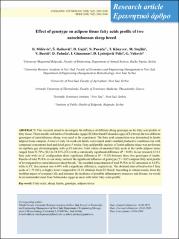Effect of genotype on adipose tissue fatty acids profile of two autochthonous sheep breed

View/
Date
2020Author
Miščević, B.
Rašković, Š.
Gajić, D.
Puvača, Nikola
Könyves, T.
Stojšin, M.
Bursić, Vojislava
Puhača, D.
Gianennas, I.
Ljubojević Pelić, Dragana
Vuković, Gorica
Metadata
Show full item recordAbstract
This research aimed to investigate the influence of different sheep genotype on the fatty acid profile of
fatty tissue. Three months old lambs of Somborska cigaja (SC) breed and Čokanska cigaja (ČC) breed, the two different
genotypes of autochthonous sheep, were used in the experiment. The fatty acid composition was determined in lambs
adipose tissue samples. A total of sixty 24-week-old lambs were reared under standard productive conditions fed with
compound concentrate feed and dried grass 5 weeks. Fatty acid profile analysis of lambs adipose tissue was performed
on capillary gas chromatography with an FI detector. Total values of saturated fatty acids in the lambs adipose tissue
ranged from 53.70% (SC) to 54.87% (ČC) with a statistically significant difference (P < 0.05). In our research C18:1
fatty acid with cis-Δ9 configuration show significant differences (P < 0.05) between these two genotypes of lambs.
Results of total PUFAs in our study indicate the significant influence of genotype (P < 0.05) adipose fatty acid profile
of investigated two autochthonous sheep breeds. The recorded concentration of total PUFAs in SC amounted to 6.15%,
while in ČC that amount was 4.69% with a significant difference, respectively. The obtained ratio of total n-6/n-3 fatty
acids of 1.79 (SC), is highly lower compared to 21.33 obtained from ČC breed. According to obtain results, from the
healthier aspect of consumer life, and decrease the incidence of possible inflammatory processes and disease, we would
be recommended meat from Sobmorska cigaja as meat with better fatty acids profile.
